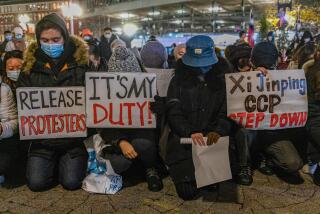Mao, Confucius and Louis Vuitton
- Share via
Mao Tse-tung, Confucius and Louis Vuitton have been mixing it up lately on China’s most-renowned stage: Tiananmen Square.
For decades, Mao’s portrait has hung over the Tiananmen Gate at the far north of the square, at the entrance to the Forbidden City, even as his embalmed body has lain in the mausoleum built immediately after his death in the center of the square. Chairman Mao, the Great Helmsman, founder of the People’s Republic of China, looms mightily over the square, reminding the Chinese people of the Communist Party’s achievement in raising the country out of its “feudal” and impoverished past and restoring it to prosperity and global influence.
On Jan. 13, Mao was joined in the square by a figure of at least equal repute in China: Confucius. Born in 551 BC, the sage, as he is known, left behind a set of teachings as influential as any the world has known. These teachings became the basis of state ideology by the 2nd century BC, and remained so, with some ups and downs, for more than two millenniums. But with the opening decades of the 20th century, prominent intellectuals and political figures took aim at Confucian teachings, arguing that they were in large part responsible for China’s backwardness and weakness relative to the West.
Mao in particular disliked what he believed to be the enduring effects of Confucius’ “feudal” practices on the people and, during the Cultural Revolution of 1966-1976, called on the Red Guards to destroy texts, temples, sites and statues throughout China associated with Confucius.
No small irony then that, suddenly, in early January, a 17-ton statue of the sage appeared in front of the north gate of the newly renovated National Museum of China — facing Mao’s 15-by-20-foot visage hanging above the Tiananmen Gate.
Now, if Mao himself wasn’t agitated, his loyal supporters apparently were. Confucius, after all, was an affront to all that Mao had stood — and fought — for. Consequently, Confucius, all 17 tons of him, disappeared on April 20, as suddenly and mysteriously as he had appeared three months earlier. No one has yet come forward with a formal explanation of the statue’s comings and goings, but pundits assume, no doubt rightly, that Confucius’ appearance and disappearance represent behind-the-scenes political jockeying between different camps within the leadership.
So, Confucius has exited the square. Enter Louis Vuitton. The French luxury goods company has taken up a perch almost exactly where the bronze Confucius had been set down. But rather than outside the north entrance of the National Museum, Louis Vuitton is inside the National Museum. Next to rare porcelain vases and bronze vessels, in a four-room exhibition, are LV luggage and handbags dating to the 1860s, reminding museum-goers of all the luxury the Chinese missed out on after the country’s fall from power in the mid-19th century. Clever marketing, especially in a country where the world’s high-end brands are all competing for visibility among a newly consumerist population.
The question that comes to mind is this: Confucius has been chased from Mao’s square, but can Louis Vuitton, the representative of capitalist luxury and wasteful consumption, be any more palatable to the chairman? Is Louis’ presence there preferable to the sage’s?
Some Chinese, among them no doubt Mao’s followers, have expressed displeasure with a Louis Vuitton show in a Chinese historical museum, of all places. Stores are one thing — there are now 27 Louis Vuitton shops in China — but a spot in the fabulously renovated National Museum in one of the world’s most historically rich squares?
Don’t assume, however, that Confucius has entirely left the stage. Having lost his much-coveted spot in Tiananmen Square, he’s moved on to Shanghai. For reasons that are not at all clear, the Shanghai Science and Technology Museum decided that the sage, with his renewed popularity, deserved a show at the very same time the museum had planned to display “Albert Einstein (1879-1955),” an exhibition owned by the Historical Museum of Bern, Switzerland.
The Shanghai museum’s motive here is unclear. Did it see a comparative-sage exhibition as a potential blockbuster? Or was it a nationalistic decision? That is, we have our Eastern sage too? Or maybe it was simply to fill gallery space. In any event, unhappy with the Shanghai’s proposal to merge the Einstein exhibition with a Confucius exhibition, the Bern museum announced June 7 that it had dropped plans to bring its show to Shanghai.
Confucius thus seems to have fared better against Einstein in Shanghai than against Mao in Beijing. Whether Confucius will have a solo show in the Shanghai museum remains to be seen. And the meaning of the showdown between Confucius and Einstein is, if possible, less clear, at least at the moment, than that between Confucius and the chairman.
What is clear, though, is that Confucius, however aged, is getting around these days.
Daniel K. Gardner is a professor of history and the director of the program in East Asian studies at Smith College and the author of ChinaMusings.com.
More to Read
A cure for the common opinion
Get thought-provoking perspectives with our weekly newsletter.
You may occasionally receive promotional content from the Los Angeles Times.









